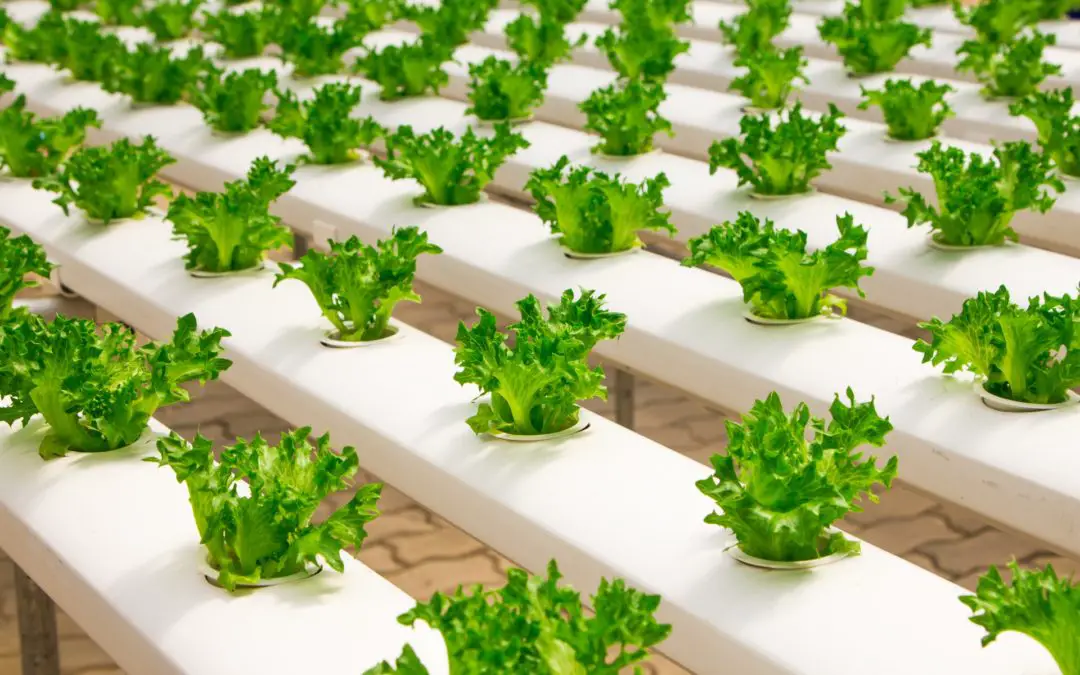NoneStarting a vegetable garden indoors is more attainable in 2020 than ever before. Costs of LEDs are dropping, more and more gardening supplies are available on Amazon. And the web is exploding with new information on how to maximize your results from every vegetable. The odds are stacked in your favor.
Maximize Natural Light
Outdoor lighting can be 11,080 to 18,176 lux whereas indoor light is often in the range of 100 – 200 lux. That means natural light can be up to 180 times stronger than indoor light. If that’s not justification for placing plants near a window or skylight, I don’t know what is!
While some microgreens can grow in the dark (popcorn shoots for example), most vegetables and herbs do best with at least 8 hours of light per day. Depending on your exposure, a spot near a window might be just what you need to give your garden a boost.
If it’s not quite enough, consider supplementing with fluorescents or LEDs. In 2020 prices are lower than ever for LEDs, and a lot of options exist for retrofitting LED’s into existing T5 or T8 fixtures.
Dial in Your Soil
It’s easy to treat all soils the same. You buy one bag, and use it for everything. But not all soil is created equal. When selecting a soil for indoor gardening or microgreens, look for:
- Sterile soil: reduce soil-born pathogens, mold, fungi, bacteria
- Microgreens: Potting mix or seed starting mix: has great well-rounded qualities, aeration, water retention, and nutrients
- Vegetables: A good vegetable mix can be organic heavy (like a potting mix), or a more fertilizer-reliant (but extremely well draining) mixture of perlite, sand, vermiculite, and peat moss or a more sustainable alternative like coconut fiber.
Select Containers Deliberately
Aesthetics aren’t the only consideration when choosing a growing container. While almost anything can be used to grow microgreens and vegetables in, there are some easy guidelines that will start your garden off on the right foot:
Microgreens:
- A 1” deep container can give microgreens enough soil to grow, and make it easier to harvest. Deeper containers make you cut your microgreens at an angle, as your tool will bump up against the edge of the tray.
- Drainage is optional, but it allows you to water from the bottom if you use a second, solid tray. The bottom tray contains the water, and the top tray contains the soil (with holes in it). The water seeps up into the soil and the roots access it from below. It keeps the top of the soil dry, reducing mold and pathogen growth near your soon-to-be harvested food!
Vegetables
- Vegetables often grow longer, and through accessing more soil they can develop deeper roots and larger produce. Consider a deeper container.
- Salad greens can be grown in shallower containers because they’re harvested a lot sooner. A few inches deep is fine.
- Anything that climbs, or grows into a taller plant, with a more developed root system, so they’ll need more soil. Deeper soil retains more moisture than shallow.
Keep Critters Down
A huge benefit of growing vegetables indoors is that you have a lot more control of who visits the garden, including insects! If you’re careful about the plants and produce you bring into your house, it’s possible to grow vegetables and microgreens without any insect problems.
But, that new tropical plant or those beautiful flowers might sneak a few stow-aways in. So how do you give your garden the best chance?
- Sanitize everything: clean any trays, containers, pots, and tools thoroughly before using them indoors. Insects and their eggs and larvae can survive a lot, and are really tiny. It might seem like overkill, but scrub everything with soap and water, and then give it a wipe down with a sanitizing agent like hydrogen peroxide, rubbing alcohol, vinegar, or bleach.
- If you already have critters: consider an insecticidal soap, or traps. I wrote an article that gets into a lot of detail on the solutions I’ve tried, some of them might surprise you!
- Quarantine new plants you bring into the house. It can be a good idea to remove the soil from new plants, spray down the roots with hydrogen peroxide, and then repot in sterile soil. It might seem like overkill, but the extra ten minutes and few dollars could save you hours down the line!
Focus on the Microclimate
A lot of plants get a boost in vigor from tweaking the temperature and humidity they’re exposed to. Leafy greens and microgreens can germinate better and grow quicker if temperatures are in the right range.
Leafy salad greens like lettuce, chard, spinach, arugula, and some root vegetables like radishes and beets prefer cooler temperatures. If you’re in a northern climate, and don’t have triple-paned windows, chances are the temperature right next to your windows is a bit cooler. Consider placing the cool temperature loving plants right next to the window, and the rest of your garden further back.
On the other end of the spectrum, make sure heat-loving crops don’t get too chilly, especially in northern climates where the temperature difference between indoors and outdoors can be a lot higher. It was -30 C/ -22 F this week outside, and + 22C/72F in my house, that’s a 94F or 52C difference!
Most microgreens prefer a consistent temperature between 68 F (20 C)and 77 F (25 C). Keeping humidity down prevents mold and other pathogen growth. Adding fan can be a great way to increase ventilation and reduce humidity as well.
Plants Need Food
Especially if you’re using a soilless mix (often to keep bugs down), you’ll need to fertilize. I prefer to fertilize more often, but using a weaker solution.
Weakly, weekly
If a fertilizer suggests 1 dose every month, I’ll often do ¼ strength, but every time I water. It’s a good idea to water with enough volume that water flows out of the bottom of your container. This way the natural salts in your water, and un-consumed fertilizer won’t build up in your soil as the plants and air remove moisture from your soil.
Fertilizers that come as a liquid or solid are both great options. Liquid fertilizers are available based on fish emulsions, seaweed, and more pure chemical forms. Solid fertilizers can be mixed into water, or some are designed to be slow-release, remaining in the soil for a period of time and feeding plants over months.
The main mistake people make is over-fertilizing. It can damage roots, and put your garden at risk. Err on the side of less rather than more.
Plants can Drown
Water makes plant life possible, but it can also end it. Herbs, vegetables, microgreens, and houseplants all need water regularly, but you can easily over-water If you’re not careful. Plant roots don’t just absorb water and nutrients from the soil, they also exchange gasses with the air in the soil. The roots “breathe”.
This is why it’s so important to have well-draining containers. Well-draining containers make sure excess water in the soil can run down out of contact with the soil.
Some plants can tolerate continually wet roots, while others need to dry out almost completely. Read up on what you’re growing, and you’ll be in good shape. In general, it’s a good idea to let at least the top 1” of soil dry out before watering.
But watch out for your shallower growing containers. Microgreen flats, or 3” pots are particularly prone to drying out, and might need water every second day, especially if it’s warm and bright where they’re growing.
Frequently Asked Questions about Indoor Vegetable Gardens
If you have a question that isn’t answered here, send me an e-mail or leave a comment below
How do I start an indoor vegetable garden?
Buy fresh seeds, from a reliable source. I’ve had incredible luck from both of these:
and
Both have high quality, high germinating seeds that give vigorous growth.
The next thing you’ll need is some clean soil (sterile is best), and a container to plant in with good drainage (remember, roots need air too, not just water and soil).
Give your new garden lots of light, keep the soil moist but not soggy, and you’ll be harvesting in no-time.
Consider starting with something more forgiving like microgreens, herbs, or salad greens like lettuce or kale.
Can you grow vegetables indoors year round?
It’s definitely possible to grow vegetables indoors year round. They’re even growing vegetables on the International Space Station. That’s about as sealed of an indoors environment as you can imagine. I grow microgreens all year long 100% indoors under fluorescent and LED lighting (I’m still experiments to find what works best for the cost).
For more info on growing in the city, check out:
10 tips for new urban farmers in 2020
When should I start vegetables indoors for my garden?
It depends what you’re growing, and how cold it gets in your area. For most northern climates, start vegetables indoors 6 months before the last frost. You can find this information for your area by doing a google search like this:
“your city” last frost date 2020
Replace “you city” with the name of your city, or the nearest city. You don’t need to include the quotes.
Another great source of information is your seed packets or your seed company. They should have fairly detailed information about everything you need to know to grow your seeds successfully. Some plants like greens or cruciferous vegetables (cauliflower, broccoli) can be started closer to when you can move them outside. So can many peas and beans.
Others like eggplants, tomatoes, or peppers can be started indoors 8 weeks or more ahead of time.
Here is a great planting schedule:
What vegetables can you grow in pots?
Almost all vegetables can be grown in pots, but some do better than others. The easiest vegetables to grow in pots are:
- Tomatoes, they do really well with warmer roots, and they like bright sun
- Herbs, If you use a larger pot, and keep the soil level 3-4 inches down from the top of the pot, the increased humidity can help keep your herbs alive when it’s warmer, and you won’t need to water quite as much (although herbs still need a lot of water).
- Microgreens grow well in pots, but you can even get away with less dirt and grow them in something shallower like a pie tin, or a large flat tray from takeout food.
Can you grow garlic indoors?
Garlic greens (similar to green onions), and garlic roots can be grown indoors! Simply plant a few cloves of garlic from the grocery store in a pot filled with potting or seed starting soil. Keep it in a bright location and water it when the top ½” of soil dries out.
To fully develop the head (the garlic you buy in-store), the plant needs cooler temperatures. This can be a bit tricky to accomplish inside, but near a window, or moving the plant into a cooler location in a basement (with artificial light) can help.

I’m Alex Lafreniere. I learned a lot about plants when I built and operated a landscaping company. But, there’s always more to learn. Ever since travelling across the world, I’ve wanted to find ways to bring more tropical and exotic plants into my life. This is the site where I share everything I’ve learned with you.
This site is owned and operated by Plant Hardware, a sole proprietor headquartered in Calgary, Canada. Plant Hardware is a participant in the Amazon Services LLC Associates Program, an affiliate advertising program designed to provide a means for sites to earn advertising fees by advertising and linking to Amazon.com.Plant Hardware may also participate in affiliate programs with Bluehost, Clickbank, CJ, ShareASale, and other sites. Plant Hardware is compensated for referring traffic and business to these companies.

